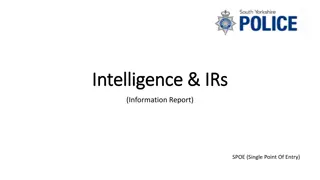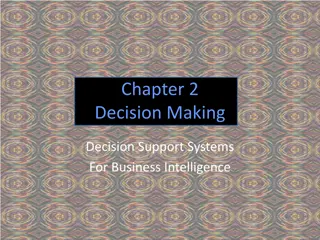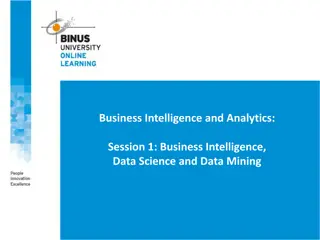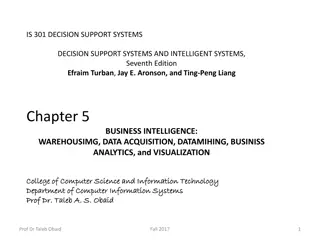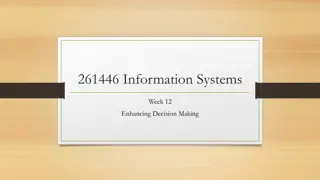Decision Support Systems for Business Intelligence Modeling
Explore the process of modeling in Decision Support Systems for Business Intelligence through images, tables, and examples. Learn about the dimensionality of models, nonlinear relationships, randomness, and Monte Carlo analysis as essential components in business decision-making.
Download Presentation

Please find below an Image/Link to download the presentation.
The content on the website is provided AS IS for your information and personal use only. It may not be sold, licensed, or shared on other websites without obtaining consent from the author.If you encounter any issues during the download, it is possible that the publisher has removed the file from their server.
You are allowed to download the files provided on this website for personal or commercial use, subject to the condition that they are used lawfully. All files are the property of their respective owners.
The content on the website is provided AS IS for your information and personal use only. It may not be sold, licensed, or shared on other websites without obtaining consent from the author.
E N D
Presentation Transcript
Chapter 4 MODEL COMPONENT Decision Support Systems For Business Intelligence
Figure 4.1: Process of Modeling Sauter, V.L. , Decision Support Systems for Business Intelligence, John Wiley, 2010
Figure 4.2: A Model Airplane Sauter, V.L. , Decision Support Systems for Business Intelligence, John Wiley, 2010
Table 4.1: Dimensionality of Models Representation Time Dimension Linearity of the Relationship Deterministic vs. Stochastic Descriptive vs. Normative Causality vs. Correlation Methodology Dimension Sauter, V.L. , Decision Support Systems for Business Intelligence, John Wiley, 2010
Figure 4.3: Screenshot from Scottrades Advanced Trading System Software Sauter, V.L. , Decision Support Systems for Business Intelligence, John Wiley, 2010
Figure 4.4: Looking at Intervals of Time for Patterns Sauter, V.L. , Decision Support Systems for Business Intelligence, John Wiley, 2010
Figure 4.5: Nonlinear Relationships Sauter, V.L. , Decision Support Systems for Business Intelligence, John Wiley, 2010
Figure 4.6: Nonlinear Higher Dimension Relationship Sauter, V.L. , Decision Support Systems for Business Intelligence, John Wiley, 2010
Figure 4.7: Nonlinearity with Randomness Sauter, V.L. , Decision Support Systems for Business Intelligence, John Wiley, 2010
Figure 4.8: Results of a Monte Carlo Analysis Sauter, V.L. , Decision Support Systems for Business Intelligence, John Wiley, 2010
Figure 4.9: Simulation with Animaion Sauter, V.L. , Decision Support Systems for Business Intelligence, John Wiley, 2010
Figure 4.10: Google Results Sauter, V.L. , Decision Support Systems for Business Intelligence, John Wiley, 2010
Table 4.2: Data-Mining Goals Classifications Clusters Regressions Sequences Forecasting Sauter, V.L. , Decision Support Systems for Business Intelligence, John Wiley, 2010
Figure 4.11: Word Cloud Analysis of a Blog Sauter, V.L. , Decision Support Systems for Business Intelligence, John Wiley, 2010
Figure 4.12: Word Tree of a Blog Sauter, V.L. , Decision Support Systems for Business Intelligence, John Wiley, 2010
Figure 4.13: DSSAgent Screen Sauter, V.L. , Decision Support Systems for Business Intelligence, John Wiley, 2010
Figure 4.14: Simple Model Selection Sauter, V.L. , Decision Support Systems for Business Intelligence, John Wiley, 2010
Figure 4.15: Simple Manipulation of a Model Sauter, V.L. , Decision Support Systems for Business Intelligence, John Wiley, 2010
Figure 4.16: Model Option Selection Sauter, V.L. , Decision Support Systems for Business Intelligence, John Wiley, 2010
Figure 4.17: Traditional Results Format Sauter, V.L. , Decision Support Systems for Business Intelligence, John Wiley, 2010
Figure 4.18: Results with Decision Support Sauter, V.L. , Decision Support Systems for Business Intelligence, John Wiley, 2010
Figure 4.19: Detailed Model Support Sauter, V.L. , Decision Support Systems for Business Intelligence, John Wiley, 2010
Figure 4.20: Passive Warning of Model Problems Sauter, V.L. , Decision Support Systems for Business Intelligence, John Wiley, 2010
Figure 4.21: Active Warning of Model Problems Sauter, V.L. , Decision Support Systems for Business Intelligence, John Wiley, 2010
Figure 4.22: Integration of Models Sauter, V.L. , Decision Support Systems for Business Intelligence, John Wiley, 2010
Figure 4.23: Modeling Results with Some Interpretative Support Sauter, V.L. , Decision Support Systems for Business Intelligence, John Wiley, 2010
Figure 4.24: Plot of Maintenance Data Sauter, V.L. , Decision Support Systems for Business Intelligence, John Wiley, 2010
Figure 4.25: Model Results with Better Interpretative Support Sauter, V.L. , Decision Support Systems for Business Intelligence, John Wiley, 2010
Figure 4.26: Passive Prompting for Further Analysis Sauter, V.L. , Decision Support Systems for Business Intelligence, John Wiley, 2010
Figure 4.27: Active Prompting for Further Analyses Sauter, V.L. , Decision Support Systems for Business Intelligence, John Wiley, 2010
Figure 4.28: Assistance for Defining Criteria Sauter, V.L. , Decision Support Systems for Business Intelligence, John Wiley, 2010
Figure 4.29: Finer Detailed Definition of Criteria Sauter, V.L. , Decision Support Systems for Business Intelligence, John Wiley, 2010
Figure 4.30: Content-Dependent Assistance of Criteria Selection Sauter, V.L. , Decision Support Systems for Business Intelligence, John Wiley, 2010
Figure 4.31: Support for Criteria Definition Sauter, V.L. , Decision Support Systems for Business Intelligence, John Wiley, 2010
Figure 4.32: Intelligent Support in a DSS Sauter, V.L. , Decision Support Systems for Business Intelligence, John Wiley, 2010
Figure 4.33: Brainstorming Support Tools Sauter, V.L. , Decision Support Systems for Business Intelligence, John Wiley, 2010
Figure 4.34: Support for Multi Criterion Choices Sauter, V.L. , Decision Support Systems for Business Intelligence, John Wiley, 2010
Figure 4.35: Specifying Criteria Sauter, V.L. , Decision Support Systems for Business Intelligence, John Wiley, 2010
Figure 4.36: Results from Analysis Sauter, V.L. , Decision Support Systems for Business Intelligence, John Wiley, 2010
Figure 4.37: Consumer Reports Data could be Accessed from a DSS Sauter, V.L. , Decision Support Systems for Business Intelligence, John Wiley, 2010
Figure 4.38: Edmunds Car Review Sauter, V.L. , Decision Support Systems for Business Intelligence, John Wiley, 2010
Figure 4.39: Queries Designed to Help User Better Understand Choices Sauter, V.L. , Decision Support Systems for Business Intelligence, John Wiley, 2010
Figure 4.40: Decision Support Results Sauter, V.L. , Decision Support Systems for Business Intelligence, John Wiley, 2010
Figure 4.41: Historical Information to Facilitate Support Sauter, V.L. , Decision Support Systems for Business Intelligence, John Wiley, 2010
Figure 4.42: Support for Users Exploring Assumptions Sauter, V.L. , Decision Support Systems for Business Intelligence, John Wiley, 2010










